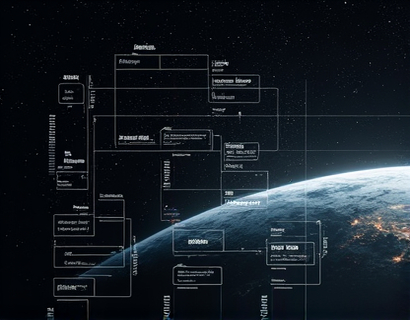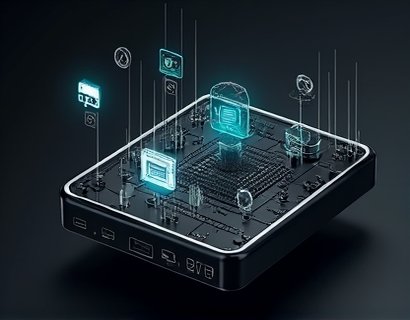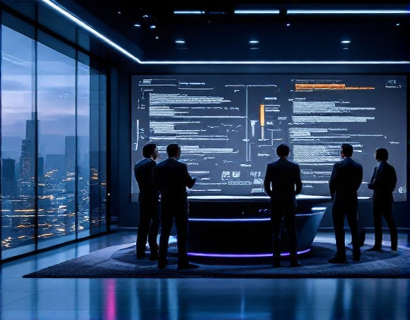Crypto AI Transformation: Maximizing Engagement and Growth in the Digital Frontier
The intersection of blockchain technology and artificial intelligence (AI) is reshaping the digital landscape, offering unprecedented opportunities for businesses and tech enthusiasts. This transformation is not just about adopting new tools but fundamentally rethinking digital strategies to maximize engagement and drive sustainable growth. In this article, we will explore how the integration of blockchain and AI can enhance online presence and foster long-term success in the dynamic crypto and tech environment.
The digital age has brought about a paradigm shift in how businesses operate and interact with their audiences. Traditional methods are being replaced by innovative solutions that leverage the power of technology. Blockchain, with its decentralized and secure nature, and AI, with its ability to process and analyze vast amounts of data, are at the forefront of this revolution. Together, they offer a powerful blend that can transform various aspects of digital strategy, from customer engagement to operational efficiency.
Understanding Blockchain and AI
To fully leverage the potential of blockchain and AI, it's essential to understand the fundamentals of each technology.
Blockchain is a distributed ledger technology that ensures transparency, security, and immutability. It operates on a network of computers, where data is stored in blocks that are linked and secured using cryptography. This technology is the backbone of cryptocurrencies but extends far beyond, finding applications in supply chain management, identity verification, and more.
Artificial Intelligence, on the other hand, encompasses a range of technologies that enable machines to perform tasks that traditionally required human intelligence. These include machine learning, natural language processing, and computer vision. AI's ability to learn from data, recognize patterns, and make decisions autonomously makes it a invaluable asset in optimizing business processes and enhancing user experiences.
Synergy Between Blockchain and AI
The true power of blockchain and AI is realized when they are combined. This synergy creates a robust framework for building trust, automating processes, and delivering personalized experiences. Here are some key areas where the integration of these technologies can drive significant value:
- Data Security and Integrity: Blockchain's inherent security features ensure that data used by AI systems is tamper-proof and reliable. This is crucial for maintaining the accuracy and trustworthiness of AI-driven insights and decisions.
- Automated Smart Contracts: Smart contracts on the blockchain can be programmed to execute automatically when certain conditions are met, as determined by AI algorithms. This automation reduces manual intervention, speeds up processes, and minimizes errors.
- Enhanced Personalization: AI can analyze user behavior and preferences, while blockchain can securely store and manage this data. The combination allows for highly personalized experiences without compromising user privacy.
- Supply Chain Transparency: Blockchain provides a transparent and traceable record of transactions, which AI can analyze to optimize supply chain operations, predict demand, and reduce costs.
Maximizing Engagement Through Blockchain and AI
Engagement is a critical factor for any digital platform, and the integration of blockchain and AI can significantly enhance user interaction and satisfaction. Here’s how:
Firstly, trust and transparency are paramount in building user trust. Blockchain's immutable ledger ensures that all transactions and interactions are recorded and verifiable, reducing the risk of fraud and increasing user confidence. AI can further enhance this by providing real-time transparency, allowing users to see how their data is used and ensuring that their preferences are respected.
Secondly, personalized experiences drive higher engagement. AI algorithms can analyze user data to deliver content, products, and services tailored to individual preferences. Blockchain ensures that this data is securely managed and that users have control over their information, fostering a sense of ownership and trust.
Thirdly, gamification and incentives can be powered by blockchain to create engaging and rewarding experiences. Tokenization, for instance, allows platforms to create tokens that can be earned and traded, motivating users to participate actively and consistently.
Case Study: Rewarding Content Creators
Consider a digital platform that rewards content creators with tokens based on user engagement metrics. AI algorithms analyze user interactions, such as likes, shares, and comments, to determine the most valuable content. These metrics are recorded on the blockchain, ensuring transparency and fairness. Creators can then redeem their tokens for various rewards, such as cash, merchandise, or access to premium features. This system not only incentivizes high-quality content but also builds a community that is actively engaged and invested in the platform's success.
Driving Growth with Blockchain and AI
Growth in the digital landscape is not just about acquiring new users but also about retaining them and expanding the ecosystem. Blockchain and AI can play pivotal roles in this process:
One effective strategy is community building. By leveraging blockchain to create decentralized governance models, platforms can involve users in decision-making processes. AI can facilitate this by analyzing community feedback and sentiment, helping to identify trends and areas for improvement. This collaborative approach fosters a sense of belonging and encourages users to become advocates for the platform.
Another approach is partnerships and integrations. Blockchain and AI can enable seamless integrations with other blockchain-based services and platforms, expanding the ecosystem and providing users with a broader range of options. AI can identify potential partners and predict the benefits of such collaborations, streamlining the process and maximizing mutual value.
Example: Cross-Platform Token Standards
Imagine a scenario where multiple blockchain platforms adopt a standardized token format, facilitated by AI-driven consensus mechanisms. This standardization allows tokens to be interoperable across different ecosystems, enhancing user experience and driving adoption. For instance, a token earned on one platform can be used to access services on another, creating a more connected and dynamic digital environment. AI can optimize this process by predicting user behavior and suggesting the most beneficial token exchanges, further enhancing engagement and growth.
Challenges and Considerations
While the potential benefits are significant, integrating blockchain and AI also comes with challenges that need to be addressed:
First, technical complexity is a major hurdle. Developing and maintaining blockchain and AI systems requires specialized knowledge and resources. Businesses must invest in skilled personnel or partner with technology providers to overcome this challenge.
Second, regulatory compliance is crucial. The regulatory landscape for blockchain and AI is still evolving, and platforms must ensure they comply with relevant laws and standards. Staying informed and proactive in this area is essential to avoid legal issues and maintain user trust.
Third, data privacy remains a top concern. While blockchain enhances transparency, it also raises questions about user privacy. Implementing robust privacy protocols and ensuring compliance with data protection regulations, such as GDPR, is vital.
Best Practices for Implementation
To successfully integrate blockchain and AI, consider the following best practices:
- Start with a clear strategy: Define clear objectives and identify how blockchain and AI can address specific business needs.
- Invest in talent: Build a team with expertise in both blockchain and AI, or collaborate with external experts.
- Focus on user experience: Ensure that the integration enhances the user journey without introducing unnecessary complexity.
- Iterate and adapt: Continuously monitor performance and user feedback, making adjustments as needed to optimize results.
Conclusion
The convergence of blockchain and AI represents a transformative force in the digital world, offering unparalleled opportunities for businesses and tech enthusiasts. By leveraging these technologies, organizations can create more secure, transparent, and engaging digital experiences that drive sustainable growth. As the landscape continues to evolve, embracing this transformation will be key to staying competitive and successful in the digital age.










































